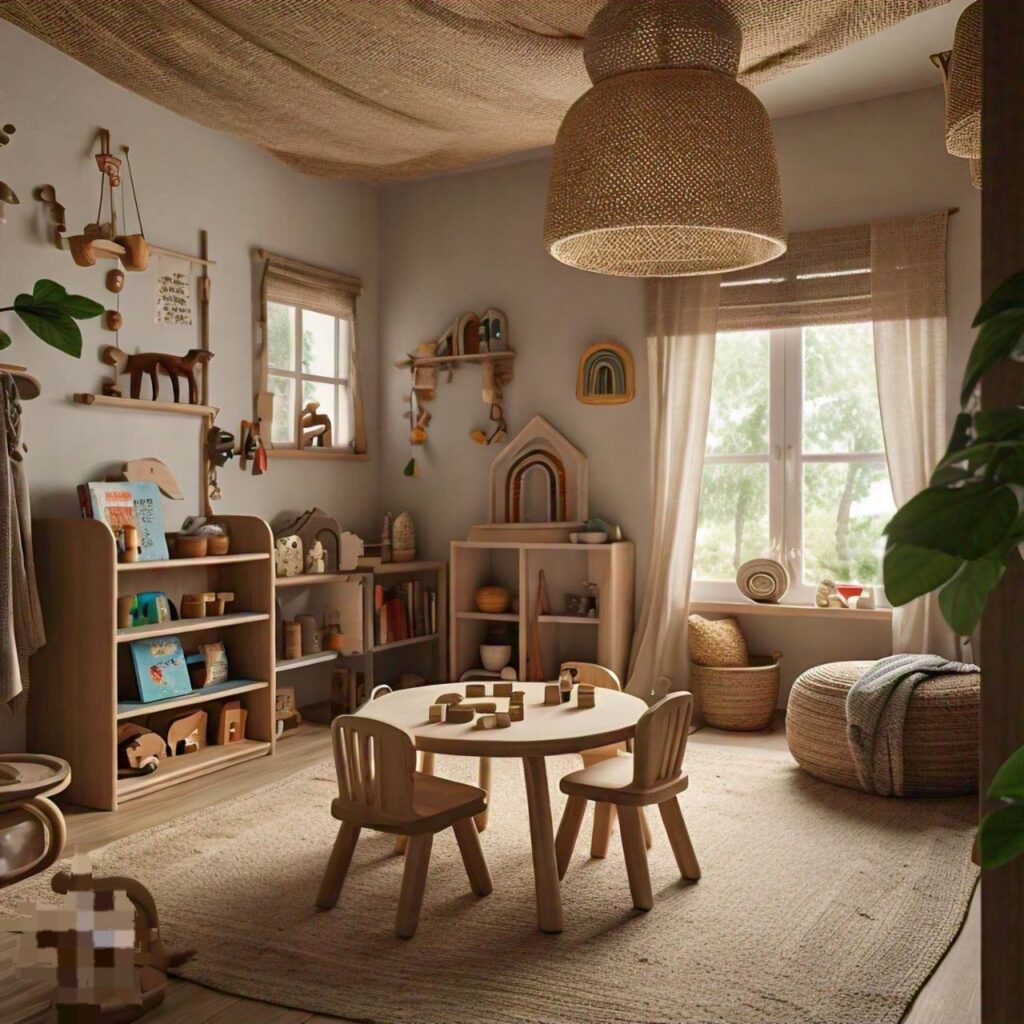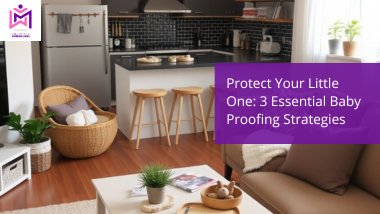
Congratulations! Your baby is starting to crawl, or maybe they’ve already taken those first steps. It’s such an exciting time, but baby proofing your home becomes essential as your little one explores. If you’re like many parents, you might find this process a bit overwhelming. Suddenly, every corner, edge and small object in your home seems like a potential hazard.
Crawlers and toddlers are naturally curious and love to explore—it’s how they learn about the world. Unfortunately, they haven’t quite figured out what’s safe and what’s not. That’s where baby proofing comes in.
Let’s face it—baby proofing your entire house can feel overwhelming at first. Where do you even begin? But don’t worry, I’ve got you covered! This guide will walk you through everything you need to know about baby proofing, from creating a checklist to finding the best products.
By the end, you’ll be ready to create a safe space for your little one and I promise we’ll keep it simple and practical!
1. Baby Proofing Checklist : Where to Start
Before you rush out and buy every baby proof product on the market, it’s important to assess your home. Every household is different, so your needs may vary depending on your home’s layout, the furniture you have and how mobile your little one is.
A simple trick? Get down to their level—literally! Crawling around your home will give you a baby’s-eye view of potential hazards you might miss from your usual standing height.
Here’s a room-by-room baby proofing checklist to get you started
1. Start Baby Proofing the Living Room & Family Areas

This is likely where you spend most of your time with your little one, so it’s important to make it as safe as possible. The living room often contains sharp corners, electronics and furniture that could easily become hazards for a mobile baby.
Anchor Heavy Furniture
Once your baby starts pulling up on things, heavy furniture like bookcases, dressers and TVs can easily tip over. Use furniture anchors or straps to secure these items to the wall to avoid accidents.
Cover Electrical Outlets
Babies love poking their fingers into electrical outlets, which can be very dangerous. Use outlet covers or sliding outlet plates to keep them safe.
Manage Cords
Provided it’s cords from blinds, lamps or electronics, they can be very tempting for little hands. Use cord shorteners or tuck them behind furniture to keep them out of reach.
Install Corner Guards
Sharp edges on tables, TV stands and other low furniture can cause injury. Foam corner guards are a quick and easy solution.
Remove Small Objects
Anything small enough to fit through a toilet paper roll is a choking hazard. Make sure to clear away small items like coins, jewelry or buttons that may be within reach.
These are just a few ways to make your living room safer. Be sure to constantly reassess the area as your child grows, as new hazards can emerge when they start walking or climbing.
2. Baby Proof the Kitchen: The Danger Zone
The kitchen is often the heart of the home, but for curious toddlers, it’s full of potential hazards. From hot stoves to sharp utensils, the kitchen requires extra care when it comes to baby proofing. Let’s dive into some essential steps:
Cabinet Locks
Kitchens are full of cabinets containing cleaning products, heavy pots, and sharp objects. Magnetic cabinet locks are a great way to secure cabinets without drilling holes, making it impossible for your toddler to get into dangerous items.
Stove Knob Covers
Tiny hands can easily turn stove knobs, which can lead to dangerous situations. Use knob covers to prevent your baby from accidentally turning on the stove.
Fridge Locks
For safety purposes, consider securing the refrigerator with a lock to prevent children from accessing its contents and potentially causing harm or damage.

Secure Trash Bins
To ensure a safe environment, secure your trash can with a locking lid or position it in a inaccessible location. This prevents unintended exploration by infants, reducing the risk of accidents in the kitchen.
3. Babyproofing the Bathroom: Bathtub and Laundry room
Bathrooms can be especially hazardous for babies and toddlers due to the presence of water, chemicals and slippery surfaces. Here’s what you should baby proof to ensure a safe environment for your child.
Toilet Locks
Baby become naturally curious as they grow. And unfortunately, toilets can be a dangerous source of fascination. Install toilet locks to prevent your little one from playing in or dropping items into the toilet, which can be a drowning hazard.
Non-Slip Bath Mats
Place a non-slip mat both in the bathtub and on the bathroom floor to prevent falls during bath time. Wet surfaces are a leading cause of injury, especially when your baby starts standing up and walking.

Medicine Cabinets
Always keep medications (prescription or over-the-counter) locked away and out of reach. A cabinet with a secure lock is a must to prevent accidental poisoning.
Keep Cleaning Products Locked
Many hygiene products stored in the bathroom can be harmful if ingested or inhaled. Make sure they are stored in locked cabinets or placed on high shelves well out of your child’s reach.
By focusing on these key areas, you can significantly reduce the risk of bathroom-related accidents.
4. Baby Proof the Nursery & Bedroom: A Checklist
Your baby’s nursery should be a sanctuary where they can sleep, play and grow safely. Here are some key ways to make the bedroom and nursery a safe place for your baby.
Crib Safety
Your baby is likely to spend a lot of time in their crib, so it’s important that it’s safe. Ensure that the slats are no more than 3/8 inches apart to avoid getting stuck, and remove pillows, blankets or stuffed animals which can be suffocation hazards.
Secure Furniture
Just like in the living room, any large furniture in the nursery should be secured to the wall. This includes dressers, bookshelves, and even changing tables. Babies often pull on furniture as they begin to stand and explore.
Use a Baby Monitor
When you’re in the next room or on another floor, a baby monitor helps you keep an eye on your little one while they’re napping or playing in their crib.
Window Locks & Guards
If your baby’s room has windows, especially on upper floors, make sure to install window locks or guards to prevent falls. It’s important to allow ventilation while keeping your baby safe.
Keep Toys Organized
Avoid leaving small or sharp toys lying around in the nursery. Keep them in baskets or toy chests that are baby-friendly, with no sharp corners or lids that can pinch fingers.
The nursery is where your baby spends most of their quiet time, so it should feel both safe and serene for you and your child.
5. Baby Proofing Your Home: Stairs & Hallways
Falls are one of the most common accidents for toddlers and babies, especially once they start walking. Here’s how to baby proof your stairs and hallways to make it safe for your baby.
Install Baby Gates
A baby gate is essential for blocking off stairs. Place them at both the top and bottom of your staircase to prevent falls. Choose hardware-mounted gates for a more secure fit compared to pressure-mounted ones. A baby gate is also useful for keeping your little one out of specific rooms.
Use Door Knob Covers
These are helpful for keeping curious toddlers out of rooms like the bathroom, laundry room, or basement. Door knob covers are easy for adults to use but tricky for toddlers to figure out.

Secure Stair Railings
Make sure your stair railings are secure. If they have wide gaps, consider installing a guard to prevent your baby from slipping through or getting stuck.
Stairs and hallways are prime areas for baby-related accidents, so take your time making these areas as safe as possible.
6. Baby Proof Outdoor Spaces: Don’t Forget the Yard
If you have a yard or patio, baby proofing isn’t limited to indoor spaces. Certain back yard elements can pose a strangulation hazard. Here’s how to keep your outdoor areas safe for your little one:
Install Fences & Gates
Ensure your yard is fenced, especially if there are hazards like a pool or pond. Install childproof gates to block off areas that are off-limits. Safety around water is crucial, so consider pool covers or alarms as extra precautions.
Cover Grills & Fire Pits
Always keep grills and fire pits covered when not in use, and make sure they’re completely out of reach for your little one.
Lock Garden Sheds & Garages
If you have a shed or garage where you store tools, chemicals, or other potentially dangerous items, be sure to keep these areas locked at all times.
Watch for Poisonous Plants
If you have a garden, be aware of any plants that may be harmful to your child. Research which plants are safe and which could be toxic if ingested. Remove any dangerous plants from your yard or garden area to prevent accidents.
Create Safe Play Areas
Designate a safe play area in your yard with soft grass or rubber matting where your baby can crawl or play without the risk of injury. Ensure this space is free from any sharp objects or hazards.
Store Outdoor Equipment Safely
Keep any outdoor toys, equipment or gardening tools secured and out of reach when not in use. Store items like lawnmowers, shovels or other gardening tools in locked sheds to avoid accidents.
By ensuring that your outdoor spaces are as safe as your indoor ones, you create a fun and secure environment for your little one to explore.
2. Baby Proofing Products: Must-Haves for a Safe Home
Now that you have a checklist of what to baby proof, let’s talk about the essential products that will help make your home safer.
Outlet Covers
Outlet covers are essential for every room. Opt for sliding outlet covers that are more permanent and secure. These prevent curious little fingers from exploring dangerous outlets.
Furniture Anchors or Straps
Prevent tipping by securing heavy furniture to the wall. Adjustable furniture straps are easy to install and provide reliable support to avoid potential accidents.
Use Baby Gates
A good baby gate can make a big difference in keeping your child out of dangerous areas like the kitchen or stairs. Look for gates that are easy for adults to open but impossible for toddlers.
Magnetic Cabinet Locks
These are great because they’re invisible from the outside and don’t require drilling. They’re perfect for keeping your toddler out of cabinets filled with cleaning products or sharp objects.
Stove Knob Covers
Prevent accidents by covering stove knobs with heat-resistant covers that are difficult for little hands to remove. This simple addition can help keep your child safe while you cook.
Corner Guards
Sharp corners on tables and counters can cause injury. Use foam or silicone corner guards to soften the blow if your little one bumps into something.
Toilet Locks
A simple toilet lock can keep your toddler from playing in the toilet, preventing potential drowning hazards.
Window Guards
Especially on upper floors, window guards prevent children from falling out while still allowing fresh air to circulate. Ensure that any windows your child can reach have these installed.
Non-Slip Mats
Use non-slip mats in the bathroom and kitchen to prevent slips and falls. These are important in areas where water can make the floors slippery.
Get your baby proofing products to secure your baby’s movement today!
3. When to Call in Professional: Baby Proofing tasks
If baby proofing your entire home feels overwhelming, you’re not alone! Many parents opt for professional baby proofing services to take the guesswork out of the process. Here’s when you might consider this option:
Home Evaluation
A professional baby proofing expert will come to your home, assess potential hazards and provide a comprehensive plan tailored to your needs.
Installation
Professionals will install everything for you, from baby gates to cabinet locks and furniture straps. This can save you time and ensure everything is correctly installed.
Custom Solutions
Every home is unique, and baby proofing experts will tailor solutions to your specific needs, ensuring every potential hazard is addressed.
Parental Education
Many baby proofing services also provide education for parents, helping you understand how to maintain a safe environment as your child grows. This knowledge can be invaluable in keeping your home safe in the long run.
If you’re unsure where to start or feel overwhelmed by the number of tasks, hiring professionals can give you peace of mind.
Conclusion
Baby proofing may seem overwhelming at first, but with a checklist in hand and the right products, you’ll be well-prepared to make your home a safe haven for your little one. If you choose to do it yourself or hire a professional, the goal is the same—keeping your child safely gated to explore and grow without the worry of unnecessary risks.
And remember, baby proofing doesn’t need to be a one-time task. As your child grows and becomes more mobile, revisit your baby proofing efforts to ensure they continue to meet your family’s needs.
It’s important to regularly reassess your home and the safety measures you’ve put in place to creating a safe environment. A child who crawls today will be a toddler running around in no time, so stay proactive about safety.
Now that you have all the tools and knowledge, it’s time to start your baby proofing journey! Enjoy watching your child explore their surroundings safely!


